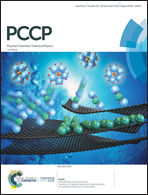High-resolution double resonance action spectroscopy in ion traps: vibrational and rotational fingerprints of CH2NH2+
Abstract
By applying various action spectroscopic techniques in a 4 K cryogenic ion trap instrument, protonated methanimine, CH2NH2+, has been investigated by high-resolution rovibrational and pure rotational spectroscopy for the first time. In total, 39 rovibrational transitions within the fundamental band of the ν2 symmetric C–H stretch were measured around 3026 cm−1, which were used to predict pure rotational transition frequencies of CH2NH2+ in the ground vibrational state. Based on these predictions, nine rotational transitions were observed between 109 and 283 GHz using a novel double resonance method, which significantly improved the sensitivity of the rotational measurements. This double resonance method consists of rotational excitation followed by vibrational excitation, which is finally detected as a dip in the number of CH2NH2+–He complexes formed in the 4 K He bath of the trap. The new measurements and the derived predictions of pure rotational transitions will enable the first radio-astronomical search for CH2NH2+.

- This article is part of the themed collection: 2019 PCCP HOT Articles


 Please wait while we load your content...
Please wait while we load your content...